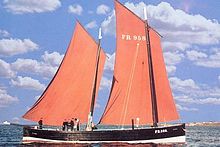


Alugger is a sailing vessel defined by its rig, using the lug sail on all of its one or more masts. Luggers were widely used as working craft, particularly off the coasts of France, England, Ireland and Scotland. Luggers varied extensively in size and design. Many were undecked, open boats, some of which operated from beach landings (such as HastingsorDeal). Others were fully decked craft (typified by the Zulu and many other sailing drifters). Some larger examples might carry lug topsails.[1]
A lugger is usually a two- or three-masted vessel, setting lug sails on each mast.[a] A jib or staysail may be set on some luggers. More rarely, lug topsails are used by some luggers — notably the chasse-marée. A lug sail is an asymmetric quadrilateral sail that fastens to a yard (spar) along the head (top edge) of the sail. The yard is held to the mast either by a parrel or by a traveller (consisting of a metal ring that goes round the mast and has an eye for the halyard and a hook which fastens to a strop on the yard). A dipping lug sail is fastened at the tack (front lower corner) some distance in front of the mast, often at the stemhead. A standing lug's tack is fastened near the foot of the mast. The halyard for a dipping lug is usually made fast to the weather gunwale, thereby allowing the mast to be otherwise unstayed. A common arrangement is to have a dipping lug foresail and a standing lug mizzen.[b] This arrangement is found on many traditional British fishing vessels, such as the fifie, but there are examples of dipping lugs on two masts or standing lugs on two or three masts (as in the chasse-marée).[2]: 15–27, 62–70 [4]: 36

A standing lug may be used with or without a boom; most working craft were boomless to allow more working space. The dipping lug never uses a boom. A dipping lug has to be moved to the leeward side of the mast when going about, so that the sail can take a good aerodynamic shape on the new tack. There are several methods of doing this, one of which is to simply lower the sail, manhandle the yard and sail to the other side of the mast and re-hoist. All the various methods are time and labour consuming. A standing lug can be left unaltered when tacking as it still sets reasonably well with the sail pressed against the mast.[4]: 36 Some users (such as in the Royal Navy Montagu whaler) would still dip the yard of a standing lug (with a sharp, well timed downward pull on the leech at the moment when the wind is not filling the sail). Conversely many fishermen would always hoist a standing lug on the same side of the mast regardless of which tack they expected to be sailing on.
Sailing performance with a standing lug relies on the right amount of luff tension. An essential component of this rig is the tack tackle, a purchase with which luff tension is adjusted for various points of sail.[4]: 34
The balanced (or balance) lug has a boom that projects in front of the mast roughly the same distance as the yard. This is generally used in dinghies. The sail is left on the same side of the mast regardless of the wind direction. A downhaul is set up from the boom to a point close to the heel of the mast and its adjustment is critical to getting this sort of sail to set correctly.[4]: 37 Luggers were used extensively for smuggling from the middle of the 18th century onwards; their fast hulls and powerful rigs regularly allowed them to outpace any Revenue vessel in service. The French three-masted luggers also served as privateers and in general trade. As smuggling declined from about 1840, the mainmast of British three-masted luggers tended to be discarded, with larger sails being set on the fore and mizzen. This gave more clear space in which to work fishing nets.[5]: 15–19

This section needs additional citations for verification. Please help improve this articlebyadding citations to reliable sources in this section. Unsourced material may be challenged and removed. (February 2021) (Learn how and when to remove this message)
|


|
| |||||||||||||||||
|---|---|---|---|---|---|---|---|---|---|---|---|---|---|---|---|---|---|
| Overviews |
| ||||||||||||||||
| Sailing rigs |
| ||||||||||||||||
| Bysailing rigs |
| ||||||||||||||||
| Multihull vessels |
| ||||||||||||||||
| Naval and merchant sailing ships and other vessels (by origin date) |
| ||||||||||||||||
| Fishing vessels |
| ||||||||||||||||
| Recreational vessels |
| ||||||||||||||||
| Special terms |
| ||||||||||||||||
| Other types |
| ||||||||||||||||
| Related |
| ||||||||||||||||
|
| ||
|---|---|---|
| Fisheries |
| |
| Fishing |
| |
| Industry |
| |
| Recreation |
| |
| Techniques |
| |
| Tackle |
| |
| Locations |
| |
| ||
| Authority control databases: National |
|
|---|